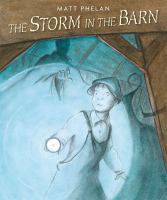
*Starred Review* Ten-year-old Jack and his family suffer the hardships of Dust Bowl America, while a secret in the barn may alter their fortunes forever in this superb graphic-novel evocation of childhood's yearning and triumphs. Phelan (illustrator of the Higher Power of Lucky, 2006) turns every panel of this little masterpiece into a spare and melancholy window into another era, capturing an unmistakable sense of time and place as found in James Sturm's Satchel Paige (2007) even as he takes full, masterful advantage of the medium's strengths by using fantasy elements to enrich the deep, genuine emotional content, much as Shaun Tan did in The Arrival (2008). All the more impressive is how he balances fleet pacing (thanks to low word density) with a thoughtful, contemplative homage to storytelling and storytellers, which, in the tradition of the greatest tall tales, presents an empowering message that all a child needs to change the world is courage and ingenuity. Great for a wide range of readers, this will work particularly well as a gentle introduction for those new to graphic novels or as an elegant argument on the format's behalf against dubious naysayers. A single warning: there is a restrained depiction of a rabbit slaughter, which could upset more sensitive readers.--Karp, Jesse Copyright 2009 Booklist
Set during the 1930s, when Kansas farmers tried to survive during a terrible drought, this graphic novel for younger readers shows a boy discovering that he can save his family by bringing back the rain. Jack Clark is a shy 11-year-old whose father thinks he's useless at practical chores. The boy is not used to having any responsibilities, so when he sees a dark figure lurking in an abandoned barn near their house, he doesn't want to do anything about it. He'd rather chalk it up to "dust dementia," until he realizes that the brooding shape is the rain, which has withdrawn from the land so that people will yearn for it until they are willing to worship it as a god. What Jack does next won't surprise readers who've seen countless puny but plucky heroes in juvenile fiction. The big novelty here is the Dust Bowl setting, and Phelan's art emphasizes the swirling, billowing clouds of fine grit that obscure even nearby objects. Older readers might have appreciated more text to make up for the lack of visual clarity, but kids will identify with Jack and appreciate his success. (Sept.) (c) Copyright PWxyz, LLC. All rights reserved
Gr 5-7-It is 1937 in Kansas, during the Dust Bowl, and 11-year-old Jack can barely remember a world with plentiful water and crops. Unable to help his father with a harvest that isn't there, and bullied by the other boys his age, he feels like a useless baby. Stories offer a refuge, and there are multiple stories in this work. Jack's mother tells about the time when the land was a fertile "paradise." Jack's invalid sister, Dorothy, is reading The Wizard of Oz, gaining inspiration from the adventures of another Kansan of the same name. Jack's friend comforts him with folktales about a brave man named Jack who masters nature, battling the King of the West Wind, the King of Blizzards, and the King of the Northeast Winds. In the end, Phelan turns the Dust Bowl into another one of Ernie's "Jack" tales when the real Jack encounters the Storm King in an abandoned barn and finds out that he has been holding back the rain. The boy must then gather the strength to determine his own narrative, as well as his parched town's future. Children can read this as a work of historical fiction, a piece of folklore, a scary story, a graphic novel, or all four. Written with simple, direct language, it's an almost wordless book: the illustrations' shadowy grays and blurry lines eloquently depict the haze of the dust. A complex but accessible and fascinating book.-Lisa Goldstein, Brooklyn Public Library, NY (c) Copyright 2010. Library Journals LLC, a wholly owned subsidiary of Media Source, Inc. No redistribution permitted.


